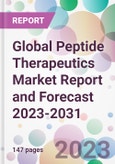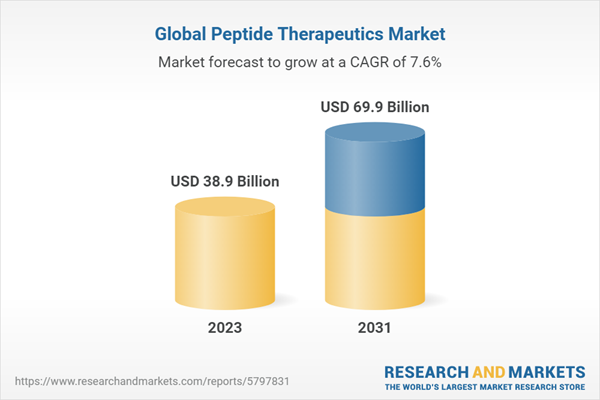The global peptide therapeutics market value was USD 36.1 billion in 2022, driven by the rising advancements in peptide synthesis technologies across the globe. The market size is anticipated to grow at a CAGR of 7.6% during the forecast period of 2023-2031 to achieve a value of USD 69.9 billion by 2031.
Peptide therapeutics possess several advantages over traditional small molecule drugs. They are highly specific and have lower off-target effects, leading to reduced side effects and improved safety profiles. Peptides can be designed to mimic natural signaling molecules in the body, allowing for targeted interactions with specific cellular receptors or enzymes. Additionally, peptides can be easily synthesized, modified, and optimized for enhanced stability, bioavailability, and pharmacokinetics.
The market for peptide therapeutics is driven by factors such as the increasing prevalence of chronic diseases, advancements in peptide synthesis technologies, and the growing understanding of disease mechanisms at the molecular level. Pharmaceutical companies are investing in research and development to discover and develop novel peptide-based drugs with improved efficacy and reduced toxicity.
In summary, peptide therapeutics represent a promising avenue for the treatment of various diseases. They offer targeted and specific interactions with cellular receptors, reduced side effects, and improved safety profiles. The market for peptide therapeutics is driven by the increasing prevalence of chronic diseases, advancements in peptide synthesis technologies, and growing investments in research and development. With ongoing innovation and regulatory support, peptide therapeutics are poised to make significant contributions to the future of medicine.
Peptide Therapeutics: Introduction
Peptide therapeutics are a class of drugs composed of short chains of amino acids, known as peptides. Peptides play a crucial role in various biological processes and can be engineered to target specific disease pathways or cellular receptors. They offer a promising approach to treating a wide range of diseases, including cancer, diabetes, cardiovascular disorders, and infectious diseases.Peptide therapeutics possess several advantages over traditional small molecule drugs. They are highly specific and have lower off-target effects, leading to reduced side effects and improved safety profiles. Peptides can be designed to mimic natural signaling molecules in the body, allowing for targeted interactions with specific cellular receptors or enzymes. Additionally, peptides can be easily synthesized, modified, and optimized for enhanced stability, bioavailability, and pharmacokinetics.
Key Trends in the Peptide Therapeutics Market
Some key trends in the peptide therapeutics market are:- Increased focus on peptide-based cancer therapies: Peptide therapeutics have shown promising potential in cancer treatment, particularly in targeted therapies and immunotherapies. There is a growing trend towards the development of peptide-based cancer drugs that can selectively target cancer cells, inhibit tumor growth, and enhance the body's immune response against cancer
- Advancements in peptide synthesis and modification technologies: The development of innovative peptide synthesis techniques, such as solid-phase peptide synthesis (SPPS) and recombinant DNA technology, has facilitated the production of complex and modified peptides with enhanced stability and bioavailability. These advancements have expanded the possibilities for peptide drug design and optimization
- Rise of peptide-based vaccines: Peptides are being explored as vaccine candidates for various infectious diseases and therapeutic indications. Peptide-based vaccines offer advantages such as improved safety profiles, targeted immune responses, and the ability to elicit specific immune reactions against disease-causing pathogens or antigens
Peptide Therapeutics Market Segmentations
Market Breakup by Type
- Branded Peptide
- Generics Peptide
Market Breakup by Applications
- Cancer, Cardiovascular Disease
- Metabolic Disease
- Respiratory Disease
- Infectious Disease
- Others
Market Breakup by Route of Administration
Oral
- Tablets
- Capsules
Parenteral
- Intravascular
- Intramuscular
Market Breakup by Type of Manufactures
- In House
- Outsourced
Market Breakup by Distribution Channels
- Hospitals Pharmacies
- Retail Pharmacies
- Online Pharmacies
- Others
Market Breakup by Region
North America
- United States of America
- Canada
Europe
- United Kingdom
- Germany
- France
- Italy
- Others
Asia Pacific
- China
- Japan
- India
- ASEAN
- Australia
- Others
Latin America
- Brazil
- Argentina
- Mexico
- Others
Middle East and Africa
- Saudi Arabia
- United Arab Emirates
- Nigeria
- South Africa
- Others
Peptide Therapeutics Market Scenario
The market for peptide therapeutics has experienced significant growth in recent years and is expected to continue expanding in the coming years. Peptide therapeutics offer unique advantages in terms of targeted therapy, reduced side effects, and improved safety profiles, making them attractive options for treating various diseases.The market for peptide therapeutics is driven by factors such as the increasing prevalence of chronic diseases, advancements in peptide synthesis technologies, and the growing understanding of disease mechanisms at the molecular level. Pharmaceutical companies are investing in research and development to discover and develop novel peptide-based drugs with improved efficacy and reduced toxicity.
In summary, peptide therapeutics represent a promising avenue for the treatment of various diseases. They offer targeted and specific interactions with cellular receptors, reduced side effects, and improved safety profiles. The market for peptide therapeutics is driven by the increasing prevalence of chronic diseases, advancements in peptide synthesis technologies, and growing investments in research and development. With ongoing innovation and regulatory support, peptide therapeutics are poised to make significant contributions to the future of medicine.
Peptide Therapeutics Market: Competitor Landscape
The key features of the market report include patent analysis, grants analysis, clinical trials analysis, funding and investment analysis, partnerships, and collaborations analysis by the leading key players. The major companies in the market are as follows:- F. Hoffmann-La Roche Ltd
- GlaxoSmithKline plc
- Novartis AG
- Pfizer, Inc
- Sanofi
- Takeda Pharmaceutical Company Limited
- Teva Pharmaceutical Industries Ltd
- Ipsen Pharma
- AstraZeneca
- Lonza
- Merck Sharp & Dohme Corp
- Novo Nordisk A/S
- PolyPeptide Group
- CordenPharma International
Table of Contents
1 Preface
3 Global Peptide Therapeutics Market Overview
4 Global Peptide Therapeutics Market Landscape
5 Global Peptide Therapeutics Market Dynamics
6 Global Peptide Therapeutics Market Segmentation
7 North America Peptide Therapeutics Market
8 Europe Peptide Therapeutics Market
9 Asia Pacific Peptide Therapeutics Market
10 Latin America Peptide Therapeutics Market
11 Middle East and Africa Peptide Therapeutics Market
12 Patent Analysis
13 Grants Analysis
14 Clinical Trials Analysis
15 Funding Analysis
16 Partnership and Collaborations Analysis
17 Regulatory Framework
18 Supplier Landscape
19 Global Peptide Therapeutics Distribution Model (Additional Insight)
21 Company Competitiveness Analysis (Additional Insight)
22 Payment Methods (Additional Insight)
Companies Mentioned
- F. Hoffmann-La Roche Ltd.
- GlaxoSmithKline plc.
- Novartis AG
- Pfizer, Inc.
- Sanofi
- Takeda Pharmaceutical Company Limited
- Teva Pharmaceutical Industries Ltd
- Ipsen Pharma
- Astrazeneca
- Lonza
- Merck Sharp & Dohme Corp.
- Novo Nordisk A/S
- Polypeptide Group
- Cordenpharma International
Methodology

LOADING...
Table Information
| Report Attribute | Details |
|---|---|
| No. of Pages | 147 |
| Published | May 2023 |
| Forecast Period | 2023 - 2031 |
| Estimated Market Value ( USD | $ 38.9 Billion |
| Forecasted Market Value ( USD | $ 69.9 Billion |
| Compound Annual Growth Rate | 7.6% |
| Regions Covered | Global |
| No. of Companies Mentioned | 14 |









